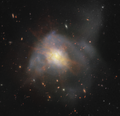File:Arp 220 - JWST, HST.png
Appearance

Size of this preview: 624 × 600 pixels. Other resolutions: 250 × 240 pixels | 499 × 480 pixels | 799 × 768 pixels | 1,065 × 1,024 pixels | 2,130 × 2,048 pixels | 4,195 × 4,033 pixels.
Original file (4,195 × 4,033 pixels, file size: 22.35 MB, MIME type: image/png)
File history
Click on a date/time to view the file as it appeared at that time.
| Date/Time | Thumbnail | Dimensions | User | Comment | |
|---|---|---|---|---|---|
| current | 22:08, 9 March 2023 |  | 4,195 × 4,033 (22.35 MB) | Fabian RRRR | =={{int:filedesc}}== {{Information |Description=A combination of JWST and HST data showing a new view of ultraluminous infrared galaxy [https://en.wikipedia.org/wiki/Arp_220 Arp 220]. Here, I've tried to cut down on the redness because if I were to simply take all the data and throw it together, much of the galaxy would be lost in a red glare. Instead, the central details are actually visible. This is important because the imagery reveals what I presume to be the cores of the two galaxies tha... |
File usage
The following page uses this file:
Global file usage
The following other wikis use this file:
